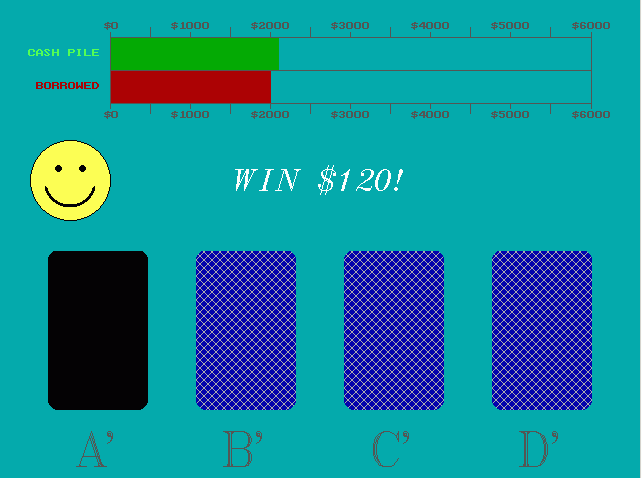Iowa gambling task
From Psy3241
The Iowa Gambling Task was developed by Bechara, Domasio, A., Domasio, R., and Anderson, S. The IGT measures a participant’s decision-making ability and ability to learn from previous outcomes. It mimics real life situations because it requires the player to act on schedules of reward and punishment, with an added factor of uncertainty.
Contents |
The Task
The participants are given four decks of cards (A, B, C and D) two of which (A and B) are disadvantageous and two (C and D) are advantageous in the long term. The examiner or computer program asks the participant to pick one card at a time (100 cards total) from any deck. The goal of the task is to accumulate as much money as you can, while picking reward (gain) and punishment cards (loss). The cards are prearranged by the examiner so that every time a card from deck A or B is chosen, the participant gets $100, whereas cards from deck C and D only reward $50. Random punishment cards are in each deck and add up to high losses in the higher paying decks (A and B) and lower losses in the lower paying decks (C and D). The losses in decks A and B add up to a loss of $1250 every ten cards, where decks C and D only add up to be a loss of $250 every ten cards. Therefore, although A and B pay more, they are disadvantageous in the long term because they result in a $250 loss every ten turns where as decks C and D are advantageous because the result in a $250 gain every ten cards.

Many computer versions of the task have been modified. Some include a green or red status bar at the top of the screen to show the participant how much they have “won” or “loss”. Measures to make the task more realistic, such as sound effects and red or black colors on the card faces are also often used.
Results
Typical normal, healthy participants initially sample all decks and usually begin picking more cards from decks C and D after around 40 trials and less cards from decks A and B. Those with decision-making impairment (damage to their Ventromedial prefrontal cortex (VMF) or amygdala) also initially sample all of the decks, but then continue to pick from the disadvantageous decks and do not increase their choices from the advantageous decks.
Physiological Results
Participant’s galvanic skin response may also be recorded during the Iowa Gambling Task. These responses indicate the presence of somatic markers. The somatic marker hypothesis suggests that emotions or “gut feelings’ have an effect on decision making. Activity is recorded for five seconds before the participant picks a card and five seconds after they look at the card. This method identifies the participant’s anticipatory response, as well as their response to reward or punishment. Participants with damage to the ventromedial prefrontal cortex or amygdala have less anticipatory galvanic skin responses than normal controls. However, when measuring reward and punishment skin responses, those with VMF damage have similar responses to normal controls. Amygdala patients have significantly lower galvanic skin responses than both groups. These results indicate that somatic states do not influence either group’s judgment, leading them to make poor decisions.
References
Bechara, A., Damasio, H., Damasio, A., R., & Lee G., P. (1999). Different contributions of the human amygdala and ventromedial prefrontal cortex to decision-making. The Journal of Neuroscience, 19(3), 5473-5481.
Facundo, M., Sahakian, B., Clark, L., Rogers, R., Antoun, N., Aitken, M., & Robbins, T. (2002). Decision-making processes following damage to the prefrontal cortex. Brain, 124, 624-639.
